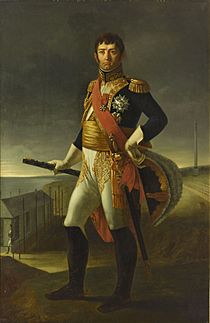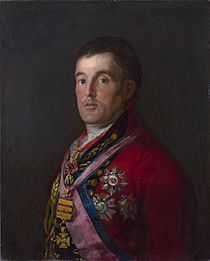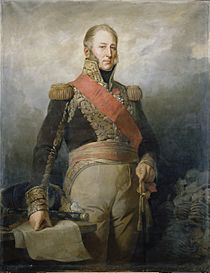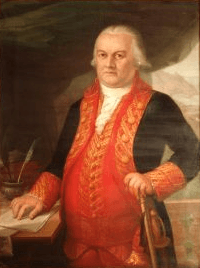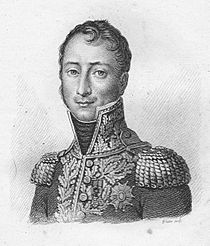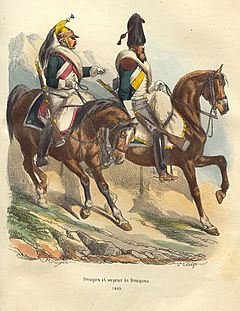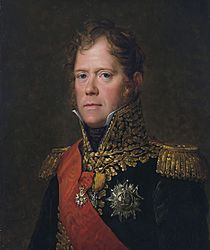Battle of Arzobispo facts for kids
Quick facts for kids Battle of Arzobispo |
|||||||
|---|---|---|---|---|---|---|---|
| Part of Peninsular War | |||||||
 The knoll where the Spanish guns were emplaced can be seen just beyond the south end of the Arzobispo bridge. |
|||||||
|
|||||||
| Belligerents | |||||||
| Commanders and leaders | |||||||
| Units involved | |||||||
| II Corps and V Corps | Army of Extremadura | ||||||
| Strength | |||||||
| 10,000 | 8,000 | ||||||
| Casualties and losses | |||||||
| 400 | 1,600 30 guns |
||||||
The Battle of Arzobispo happened on August 8, 1809. It was a fight during the Peninsular War, which was part of the bigger Napoleonic Wars. French troops, led by Marshal Jean-de-Dieu Soult, crossed the Tagus River to attack a Spanish force. The Spanish, led by the Duke of Alburquerque, were quickly defeated. They lost many soldiers and 30 cannons. The battle took place near El Puente del Arzobispo (The Archbishop's Bridge) in Spain.
The French won this battle by surprise. They found a secret shallow part of the river (a ford) and crossed it while the Spanish were resting. This allowed them to attack quickly and win.
Contents
Why the Battle Happened
French Plans and Moves
In late July 1809, the British and Spanish armies won the Battle of Talavera against King Joseph Bonaparte's French army. However, the British army, led by Arthur Wellesley (who later became Wellington), had many wounded soldiers and not enough food or supplies. This meant they couldn't chase the French.
Meanwhile, Marshal Soult was gathering a large French army. On June 12, Emperor Napoleon ordered Soult to lead three army corps (large groups of soldiers) to attack the British. Soult's goal was to cut off the British army's escape route to Portugal.
Soult's forces, including Marshal Édouard Mortier's V Corps and Soult's own II Corps, began marching south. Another French corps, led by Marshal Michel Ney, followed them. Napoleon wanted Soult to keep his armies close together. This would stop them from being defeated one by one.
At the same time, a Spanish army under General Francisco Javier Venegas was supposed to stop another French group from helping King Joseph. Venegas failed, but this opened a path to Madrid. Wellesley hoped Venegas's actions would make the French retreat. However, Venegas's army stopped moving for several days. King Joseph pulled his army back to a position where he could block either Venegas or Wellesley.
Wellesley then heard that a French force was moving from the north. He thought it was a small group, but it was actually Soult's much larger army. On August 1, the French captured Plasencia, which was on Wellesley's supply route. Wellesley decided to move his British troops west to protect his supplies. He didn't know he was marching right into Soult's trap.
The Rush to Safety
On August 3, French cavalry captured a message from Wellesley. It said he thought Soult's army was small. Soult realized Wellesley was walking right into his trap. Luckily for the British and Spanish, Spanish fighters (guerillas) caught a French spy. They gave his message to the Spanish general Gregorio García de la Cuesta. This message revealed that Soult had over 30,000 soldiers.
Cuesta quickly told Wellesley. Realizing the danger, Wellesley immediately ordered his army to retreat across the bridge at Arzobispo. Cuesta also retreated from Talavera, leaving behind 1,500 badly wounded soldiers because there weren't enough wagons. Many of these wounded men either died or were captured by the French.
By the evening of August 4, Wellesley's army was safe across the Tagus River at Arzobispo. But Cuesta refused to retreat further. He even attacked the French soldiers who appeared. Mortier, thinking he faced both Wellesley and Cuesta, became careful. He waited for Soult to join him. This gave the Spanish army a chance to escape. By August 6, when Soult and Mortier were ready to attack, the Spanish had already crossed the river.
Wellesley ordered some of his troops to march west to protect another river crossing at Almaraz. These soldiers marched for 15 hours on very little food. They were exhausted. Meanwhile, Cuesta's main army was slowly moving over the hills. To protect their retreat, two Spanish divisions, led by Bassecourt and Alburquerque, stayed behind at the Arzobispo bridge as a rear guard.
The Battle at Arzobispo
Setting Up for the Fight
The Spanish left the Arzobispo bridge standing. But they built barricades and placed infantry soldiers in the old towers to defend it. On the south side of the river, a small hill with a 12-gun fort (redoubt) guarded the bridge. Alburquerque had about 5,000 foot soldiers and 3,000 horsemen.
There was a shallow part of the river (a ford) nearby. It was narrow and hard to find. Cuesta hoped his rear guard could hold back Soult's larger army. Soult spent August 7 looking at the strong Spanish position and sending scouts to find other ways to cross the river.
The town of Arzobispo is on the north side of the Tagus River. The village of Azután is on the south side, to the east. The ford was between Azután and the bridge. During the day, Spanish cavalry soldiers carelessly rode their horses into the river to drink, showing the French where the ford might be. That night, French officers carefully searched and found the hidden ford. They discovered it was only deep for a short distance near the north bank. Soult decided to attack there the next day.
The Armies Involved
Alburquerque's Spanish forces included cavalry regiments like the Alcantara and Extremadura Hussars. His infantry divisions had soldiers from the Real Marina and Murcia Regiments. They had 16 cannons.
The French V Corps, led by Marshal Mortier, had two infantry divisions. These included regiments like the 17th Light and 40th Line Infantry. Their cavalry brigade had the 10th Hussar and 21st Chasseurs à Cheval Regiments. The V Corps had 30 cannons.
The French II Corps, led by Soult, also had cavalry and infantry divisions. Their cavalry included the 1st Hussar and 8th Dragoon Regiments.
The French Attack
Alburquerque placed only one cavalry regiment and a few infantry battalions at the river bank and the bridge. The rest of his soldiers were held further back. Soult planned his attack for the Spanish siesta (afternoon rest).
Around 1:30 PM on August 8, 1809, about 600 French dragoons (cavalry) led by General Auguste-Jean-Gabriel de Caulaincourt suddenly appeared. They quickly rode into the river and crossed the deep part of the ford. They soon reached the shallow water on the south bank.
The Spanish 1st Extremadura Hussar Regiment and an infantry battalion tried to stop the French cavalry. But Caulaincourt's dragoons quickly defeated the Spanish hussars. The French horsemen then charged the Spanish infantry. The Spanish tried to form a defensive square, but the dragoons broke through before they could finish. Many Spanish soldiers were killed or captured.
As Caulaincourt's dragoons finished their attack, more French cavalry poured across the ford. Soult then ordered an infantry brigade to attack the bridge. The French infantry, supported by cannon fire, rushed forward. Seeing that the French cavalry would soon cut them off, the Spanish infantry fired two quick shots and ran away. The fort and all its cannons were captured by the French.
Alburquerque desperately tried to rally his soldiers. Four infantry battalions formed a line about a mile south of the bridge. The cavalry quickly got on their horses. Alburquerque sent his horsemen to attack the French without waiting for them to form proper lines. About 2,500 Spanish cavalry charged into the French dragoons in a big, messy group. But more French cavalry joined the fight. Soon, Alburquerque's outnumbered horsemen were defeated.
Alburquerque bravely tried one last time with his remaining cavalry, but this effort also failed. The Spanish cavalry scattered, with the French chasing them. Seeing their cavalry defeated, the Spanish infantry also broke and ran. They retreated into the hills, suffering few more losses. The chase ended when the French cavalry met a Spanish infantry and cavalry division that was ready for battle further down the road.
What Happened Next
The Spanish lost about 800 soldiers killed or wounded, and 600 were captured. They also lost 400 horses, 16 cannons, and one flag. The French reported losing 28 cavalrymen killed and 83 wounded, plus a few soldiers who drowned.
During the chase, Soult's cavalry found a convoy of cannons that the Spanish had taken from the French at Talavera. The French got back 14 or 15 of these cannons. This allowed some French generals to falsely claim they hadn't lost any cannons at Talavera.
Soult stopped his attack because it was pointless to chase the Spanish into the mountains. He wanted to prepare for a big invasion of Portugal. However, King Joseph ordered Marshal Ney's corps to return north to help another French general. Soult's remaining two corps were placed on defense. This allowed another French corps to march east against Venegas. The next battle was the Battle of Almonacid on August 11, 1809.
These events ended the Talavera campaign. Wellesley was given the title of Viscount Wellington for his victory. Because his troops were starving, Wellington moved his army to a place where he could get enough supplies. He learned a very important lesson about how vital it was to have good supplies.
Wellington was unhappy with the Spanish army's behavior. He decided not to work with them again until their generals and soldiers became more reliable. He told the British government that he could defend Portugal against a large French army. To do this, Wellington ordered the building of the Lines of Torres Vedras, a series of forts and defenses to protect Lisbon.
See also
 In Spanish: Batalla del Puente del Arzobispo para niños
In Spanish: Batalla del Puente del Arzobispo para niños


